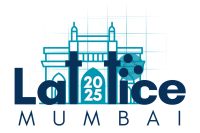Speaker
Description
We aim to explore the $Z_b$ tetraquark channel, $\bar{b}b\bar{d}u$, with quantum numbers $J^{PC}=1^{+-}$. Our approach involves calculating correlators among three operator classes: (i) static-light pair, (ii) quarkonium plus pions, and (iii) the novel interpolator based on BOEFT (Born–Oppenheimer Effective Field Theory) proposed in Ref. [1]. We use the GEVP variational approach to extract the preliminary eigenenergies and overlap factors from the correlation matrix. At short distances, at leading order, this novel interpolator has zero overlap with quarkonium and pions due to the $Q\bar{Q}$ pair being in a color-octet configuration, whereas at large distances it conveniently evolves into a heavy-light pair, making it a suitable choice to calculate the tetraquark static energies on the lattice. To achieve this, we employ the distillation technique on a CLS ensemble with $N_f=2+1$ and $m_{\pi}=290$ MeV.
In the limit of zero spatial separation between the static quark and antiquark, the diagonal correlator associated with the novel interpolator reduces to the correlator of an adjoint meson, i.e., a state composed of a static adjoint source bound to a light quark–antiquark pair. We will present the preliminary spectrum of the corresponding $I=1$ adjoint mesons in the scalar, pseudoscalar, and vector channels. For this, we use $N_f=3+1$ ensembles produced with the openQCD package [2], with $m_{\pi}=406$ MeV, $N_{\sigma}=32$, and $N_\tau=96$, with open boundary conditions in time.
[1] Matthias Berwein, Nora Brambilla, Abhishek Mohapatra, and Antonio Vairo. Hybrids, tetraquarks, pentaquarks, doubly heavy baryons, and quarkonia in Born–Oppenheimer effective theory. Phys. Rev. D 110(9):094040, 2024.
[2] ALPHA Collaboration. Scale setting for $N_f=3+1$ QCD. Eur. Phys. J. C 80 (2020) 349 [2002.02866].
| Parallel Session (for talks only) | Hadronic and nuclear spectrum and interactions |
|---|

